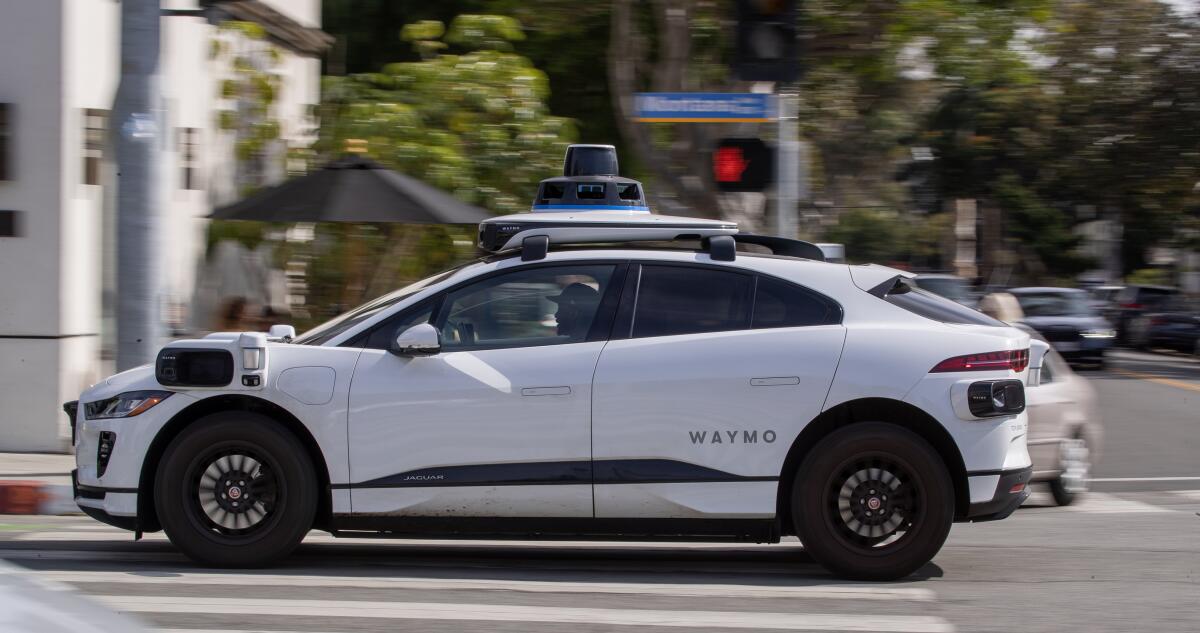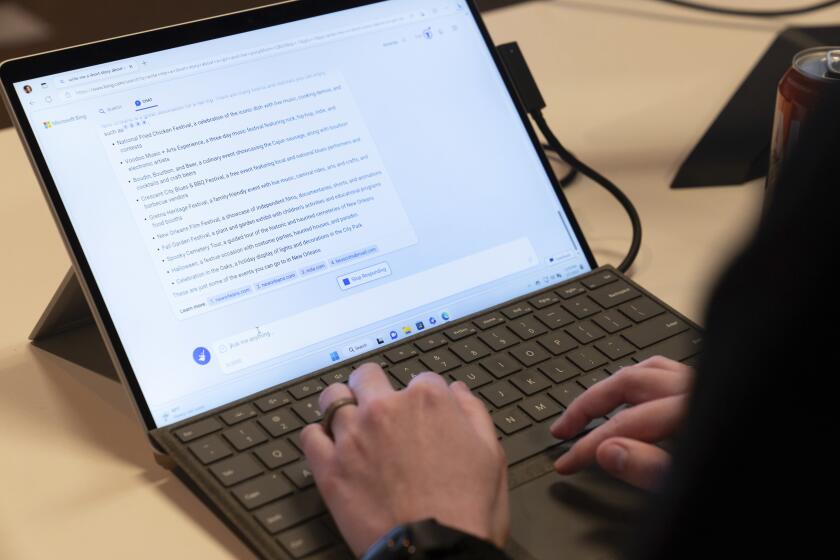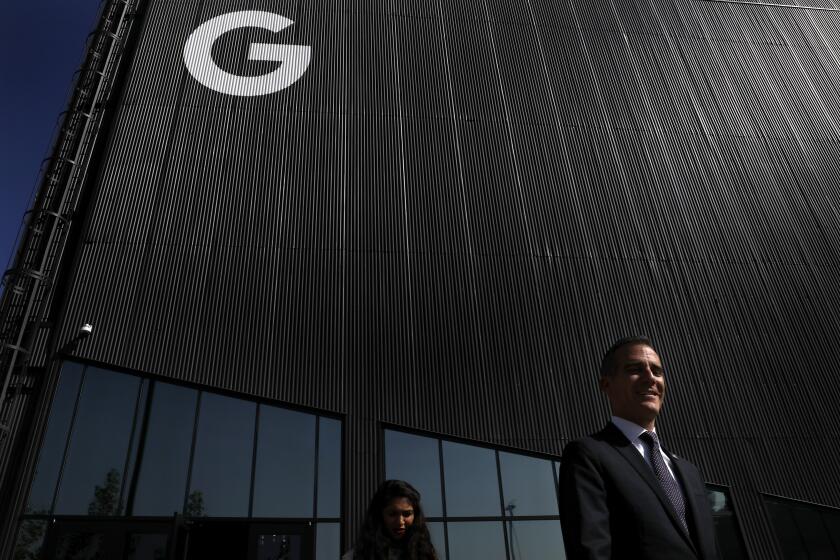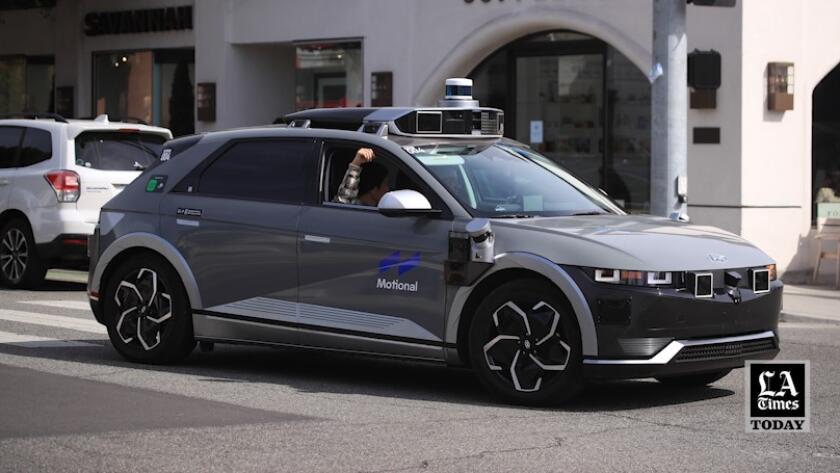Column: Will self-driving cars make L.A.’s world-famous traffic even worse?

- Share via
For some reason — no one seems to know just why — the self-driving cars can’t stay away from a random sleepy block in Santa Monica.
You can see for yourself: Get a cup of coffee at Primo Passo on 7th and Montana, and take a seat. Before long they’ll cruise by, one after another — Waymo’s autonomous taxis, white electric Jaguar SUVs with a bulbous sensor apparatus spinning up top. I sat on the corner for less than an hour and counted at least 10 self-driven laps.
“I’m here every single morning, and they’re driving by. All day, they’re driving by,” says Jennifer, a film producer and local resident, who asked that I not use her last name. “It’s a fixture down here,” she adds. “It’d be nice to know why.”
As we chat, another one pulls up to the stop light. I jog over and ask the safety driver behind the wheel — behind but not touching it — why they’re circling the block. “There’s no specified route,” he says, smiling, as the car pulled away. Five minutes later, another one rolled up.
Waymo’s self-driving cars arrived in Los Angeles last fall. They’re still in test mode, and each one has a safety driver while the company awaits approval to operate commercially. It’s the third major market that the Google sister company has entered, after Phoenix, where autonomous vehicles can now be summoned by consumers using the Waymo One app, and its home turf of San Francisco, where test vehicles are now truly driverless.
There are just a few dozen Waymo robotaxis in the Los Angeles area right now, according to the company, in places such as Santa Monica, Koreatown and the Miracle Mile. Few cities stand to be affected by self-driving cars as dramatically as L.A., home of infinite congestion and two-hour commutes, where the utterance of “traffic” and a shrug can absolve you of any tardy arrival, and where the same horrifying photo of backed-up Thanksgiving traffic on the 405 goes viral every year because it never stops being true.
And sure, Waymo’s licking its chops at the prospect of profiting off all that: Not only is L.A. a much bigger city than Phoenix or San Francisco, but there’s a sense that if you can handle the traffic here, you can handle it anywhere; in the western U.S., at least, it’s the final boss of urban car culture.
What would it mean for riders, drivers and the city at large if the company succeeded? If robotaxis became trusted, affordable — and replaced cabs and Lyft? On Valentine’s Day, I boarded one of those roaming Waymo Jaguars to find out — a date with autonomous vehicular destiny, if you will.
Google and Microsoft think chatbots that can converse like humans are the future of web search. But the human workers who make sure they don’t screw up are treated as disposable.
I meet Sandy Karp, a Waymo communications manager, and Vishay Nihalani, a project manager, at Virginia Avenue Park. The day is crisp and clear, ideal conditions for sensors designed to map and navigate an environment in real time.
Karp summons the car with a tap of her phone, and in short order, an SUV arrives with her initials lit up on a roof display. The cylindrical apparatus also contains Waymo’s key technologies: a lidar sensor (short for light detection and ranging) along with a built-in long-range camera and radar. Combined, the array of sensors, computers and software is called the Waymo Driver; the idea is that the tech will be modular and attachable to other vehicles too.
We hop in, say hello to Lindsay Arlar, the autonomous specialist in the driver’s seat, and the self-driving Jaguar eases us onto Virginia Avenue. The car moves steadily and confidently, somehow feeling exactly like what it is: the precise average of a driving experience as determined by software trained on millions of miles’ worth of data.
The prospect of supplementing those data is one of the upsides of expanding to L.A. “There are 13 million people here, with a diverse user base,” Nihalani says. “We’ve got some people that are commuting, some that are going out to the beach on the weekend across town, obviously there’s a vibrant nightlife.”
As we talk, the Driver handles traffic stops smoothly, slows down for a construction site and maneuvers around the admittedly minor obstacles we encounter on Santa Monica’s relatively wide, clean streets. It makes human-like judgment calls, such as swinging wide to avoid some debris near the curb when there’s no oncoming traffic.
Nihalani won’t give me any concrete information about the obstacles it hasn’t handled so smoothly. It’s worth noting that last year, a National Highway Traffic Safety Administration report showed that Waymo was involved in the most traffic accidents of any automated driving system by far; 62 crashes from July 2021 to May 2022.
Nihalani says one of the biggest challenges is operating in areas where people tend to ignore the speed limit — the Waymo vehicles won’t speed, so the Driver will be going 35 miles per hour while traffic zips by at 50. Same with the infamous left turn on red; it’s technically against the law, so Waymos won’t do it. But the line of drivers behind you will give you hell if you don’t take it.
Drivers are more aggressive here, Arlar says — if the Waymo car is going too slow, they’ll just go right around. “People have rear-ended us, you know,” Nihalani says.
Increasingly offering products untethered to the average consumer’s needs, the tech industry has been dwelling in La La Land. Its real-world expansion into L.A. is no coincidence.
It’s hard to get that “oh man, I am being driven around by a robot” sensation when the car is filled with Waymo employees. In fact, the most nerve-wracking thing about the experience may have been the intensity with which the autonomous specialist in the driver’s seat perches her hands over the steering wheel, giving this rider the impression that things could go haywire at any moment, though they never do.
The sense of being over-supervised compounds when the disembodied voice of someone named Scott beams into the cabin to make sure we’re following the rules. “I’m calling to remind everyone that the policy states that only three riders are allowed in a Waymo,” he says. Scott’s team, it transpires, does “rider checks,” monitoring the interior of Waymo vehicles via video from an office in Arizona. No one had told him my fellow passengers were Waymo employees.
After half an hour, the ride complete, we disembark. The Driver system didn’t disengage at any point, suggesting the trip went about as well as possible.
If anything, perhaps it went a little too smoothly, prompting me to imagine a world where easygoing autonomous commutes are the norm. In a city that already takes too many car trips as it is, what happens when you make getting around by car that much less demanding?
“I really worry about that,” says David Zipper, a mobility expert and visiting fellow at Harvard Kennedy School. “If it works, and it scales, what effect is that going to have on a city like Los Angeles?”
Zipper points to a theory called Jevons Paradox, which says that making something easier or more plentiful induces people to consume more of it. “If you apply that to autonomous driving tech, these things are designed to make driving easier, and as human beings we’re going to respond by driving more. That means more vehicle miles traveled, more sprawl because people become more tolerant of longer car trips, and more impact on the environment.”
That’s to say nothing of the potential impact on taxi and rideshare jobs — there are more than 100,000 vehicles registered with Uber and Lyft in L.A., and 2,364 cabs, and the notion of that many workers having to square off with well-funded autonomous competitors isn’t a pretty one.
Zipper also worries that the embrace of shiny new tech solutions such as autonomous cars — like former Mayor Eric Garcetti’s embrace of Waymo, perhaps — undermines efforts to improve less glamorous but more affordable and sustainable modes of transit.
Politicians look at ambitious, tech-heavy transit solutions such as ride-hailing apps, or the giant underground tunnels Elon Musk is hawking, and think they’ve found a magic bullet, or at least something exciting they can sell to voters. They wind up diverting resources, focus and legislative will away from things like buses and metro lines — stuff that works, that L.A. is desperate for, and that would work a whole lot better if it were adequately funded and executed.
More concretely, driverless cars could worsen what’s already the bane of every Angeleno’s existence. “I mean, my God, you think you have congestion now,” Zipper says, “think about traffic when everyone is in the back seat of a self-driving car.”
And I was thinking about traffic as another Waymo made its way past the coffee shop, maybe No. 7 or 8 of the hour, in Santa Monica. The scene reminded me of a story about Waymo cars inexplicably directing themselves to a residential cul-de-sac in San Francisco; residents there had no idea what was going on, except that it boded poorly for the future of local traffic.
So far, the cars don’t seem to have bothered the locals, though everyone I spoke with had noted their sudden predominance in the area. “As long as someone’s behind the wheel in case they go haywire,” says David Shoucair, an architectural designer. “I’ve seen enough videos of that to see that this technology is a ways off.” At a moment when autonomous competitor Tesla just announced a recall of hundreds of thousands of cars with so-called Full Self-Driving software, that seemed the prevailing attitude. “It’s scary, still, to me. When I see that car down the street and nobody’s in it,” Jennifer says, “I might freak out.”
While the safety concern is a real one, my fears are more aligned with Zipper’s. It’s not so much that they don’t work as well as they should but rather what happens if they do. Is this really the future we want? More luxury SUVs on the already crowded streets of L.A., struggling to adapt to organic traffic patterns, with single passengers in the back seat, watched over on a video feed by contract workers in Arizona as we tap around on our phones, alone?
- Share via
Watch L.A. Times Today at 7 p.m. on Spectrum News 1 on Channel 1 or live stream on the Spectrum News App. Palos Verdes Peninsula and Orange County viewers can watch on Cox Systems on channel 99.










